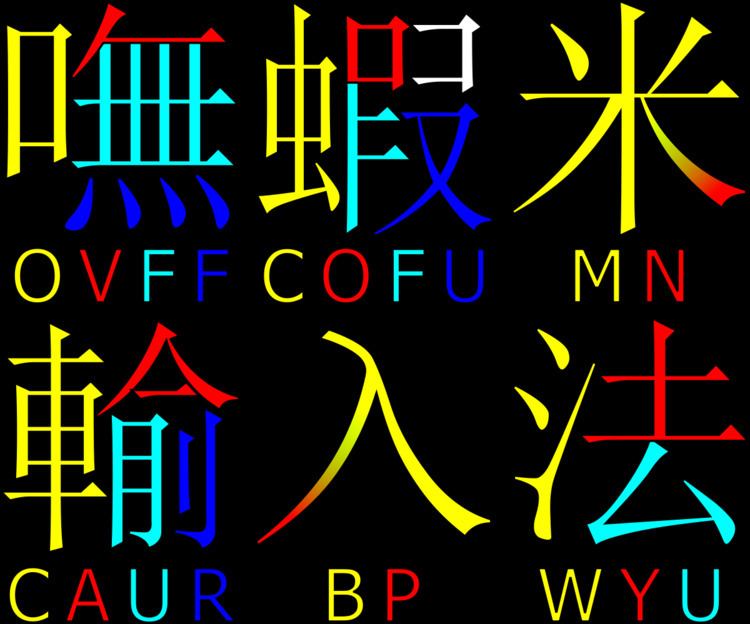 | ||
Boshiamy (Chinese: 嘸蝦米, sometimes written 無蝦米, a Mandarin approximation of the Taiwanese phrase 無甚物 (Pe̍h-ōe-jī: bô-siáⁿ-mi̍h), meaning "It's nothing!") is a Chinese character input method editor (IME). It was invented by Liu Chung-tz'u (劉重次).
Contents
- Categories of radicals
- Shapes
- Sounds
- Meanings
- Variants
- Others
- Order
- Supplementary letter
- Selection
- Shortening of code
- Other features
- References
Boshiamy uses about 300 radicals represented by 26 letters to build characters. Radicals are mapped to letters by their shapes, sounds or meanings.
Boshiamy has become one of the fastest input methods by shortening codes of many characters. Speeds exceeding 200 characters per minute have been achieved in typing contests. Boshiamy was originally designed to input traditional Chinese characters, but now it also supports simplified Chinese character input. However, it is commercial software, and users may not be able to use it on some computers. A trial version with fewer characters is available on the official site.
Categories of radicals
The inventor of Boshiamy divided radicals into several categories as a mnemonic for learners to master radicals. All categories of radicals are treated equally in practice.
Shapes
Some radicals are mapped to letters with similar shapes. For example, some characters which entirely consists of these radicals are 哈 (O, A, O), 命 (A, O, P), and 州 (Y, Y, Y).
Sounds
Some radicals are mapped to letters by their sounds. For example, the character 粉 is represented as MBD, which respectively correspond to the radicals 米 (mǐ), 八 (bā), and 刀 (dāo).
Also, some radicals are mapped to letters with English names similar to their pronunciations: 一 (yī) is E, 二 (èr) is R, 西 (xī) is C.
Meanings
Some radicals are mapped to the first letters of their English meanings. For example, 木 (tree) is T, 車 (car) is C, 中 (center) is C.
Variants
Some radicals look similar to other radicals, and are mapped to the same letter. For example, 史 is similar to 中, and is represented by C.
Others
A few radicals are mapped to letters arbitrarily. For example, 才 is U, 與 is E, 土 is Y.
Order
Characters are decomposed into what users call "eye order" (眼順), that is essentially from left to right, from top to bottom. Because of the numerous radicals available, decomposition is not difficult. For some characters the order differs from stroke order; for example the dot of 戈 is written last, but is taken first in the code because it is at the top.
Supplementary letter
The first three and the last radical of a character are taken as its code. If there are less than three letters, a supplementary letter (補碼) is added according to the shape of the last stroke of character. For example, the codes of 中 and 史 are both C, which have one letter only, so supplementary letter I and X are added respectively, making their codes CI and CX.
Selection
In case more than one character correspond to the same code, an extra letter can be added for selection. For example, there are three characters (玻, 玫 and 攷) for the code KPX. 玻 can be input directly with this code, 玫 can be input by appending V to the code, and 攷 by appending R. Boshiamy allows a maximum of five letters to be inputted at a time, so even for four-letter code an extra letter can still be added. Characters can also be selected by number keys.
Shortening of code
To increase input speed, a number of most common characters are given shorter codes of one or two letters. For example, 的 (originally PDNA) is D, 對 (FEBA) is A, 會 (ADAV) is AD.
Additional "brevity radicals" (簡速字根) are made available for shortening the codes of more characters. For example, the original code of 提 is JDEZ with the usual radicals, but using a brevity radical 是 (J), it is shortened to JJN (with supplementary letter N for the last stroke).
Boshiamy provides a special input mode for users to master these short codes. In this mode, users can only input a character by its shortest code, otherwise it does not output the character, but instead shows users the character alongside its shortest code.
Other features
Boshiamy supports Unicode. Zhuyin, Japanese kanji and kana, and other special symbols can be input directly with Boshiamy. Users can add new codes for characters or phrases.
